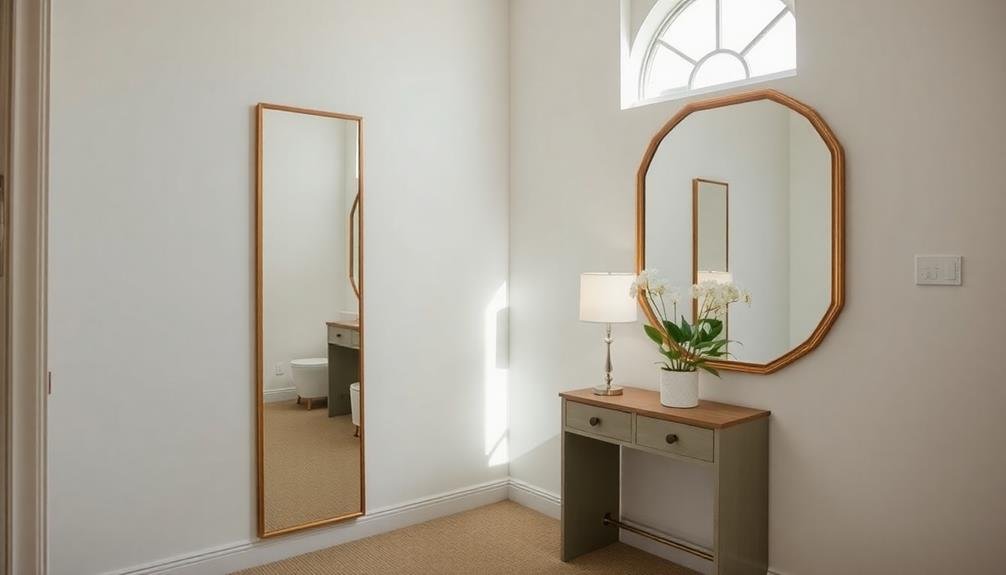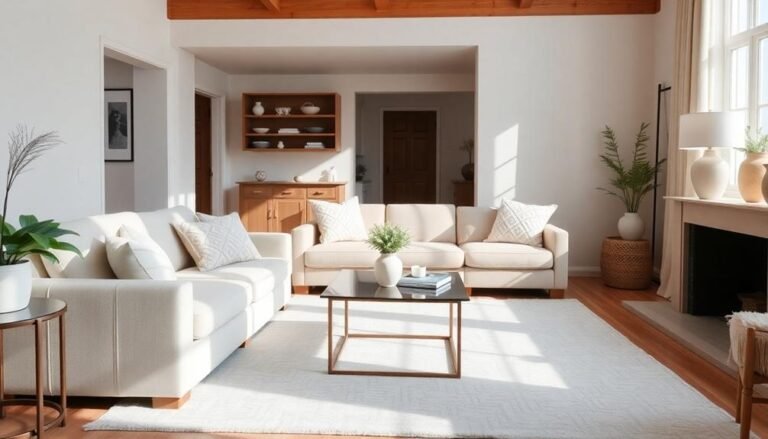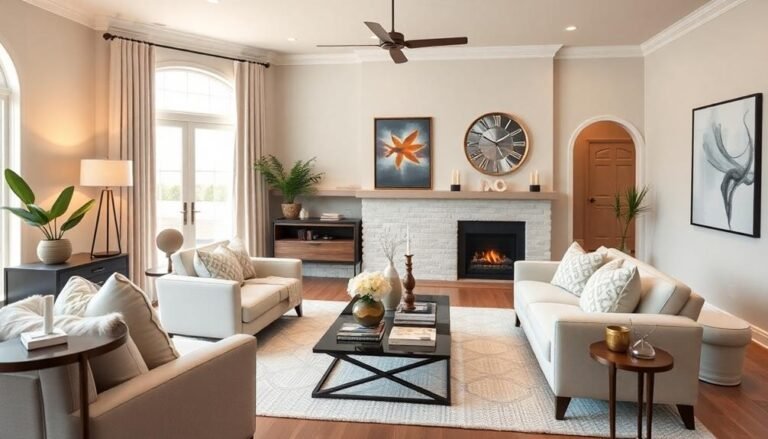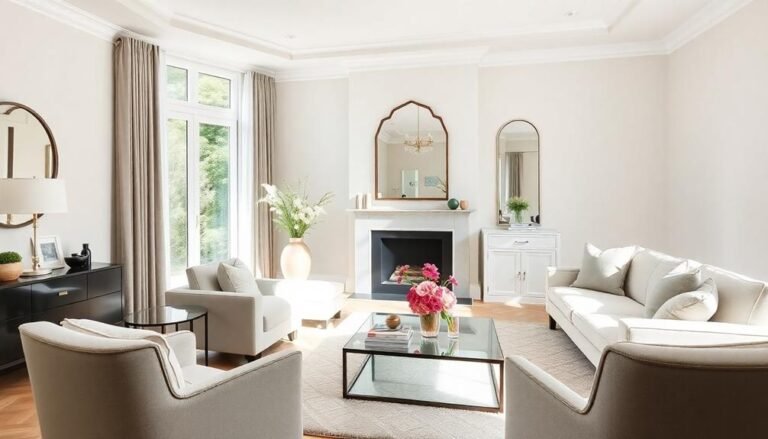To make small rooms look bigger, use mirrors and effective lighting strategically. Choose mirrors that are two-thirds the height of your furniture and place them across from windows to reflect natural light, enhancing openness. Opt for large wall-mounted or floor-to-ceiling mirrors to create depth. Layer various lighting types—ambient, task, and accent—to add warmth and dimension. Utilize natural light by keeping windows unobstructed and consider lighter wall colors to brighten the space. Avoid crowding with excessive decor or furnishings to maintain flow, allowing the room to breathe. There's so much more to explore about maximizing space, so keep exploring!
Choosing the Right Mirrors
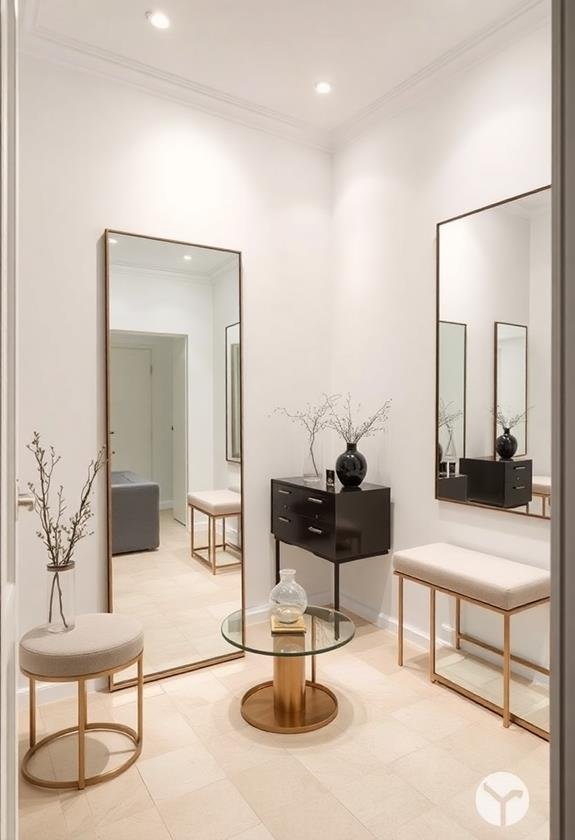
When it comes to choosing the right mirrors for small rooms, you'll want to think about both size and placement. Selecting the right size is vital; oversized mirrors can overwhelm a compact space, while too-small mirrors might not have the desired effect of expanding your room visually. Aim for mirrors that are proportionate to your walls and furniture. A mirror that's roughly two-thirds the height of your furniture can create a harmonious balance, drawing the eye upwards and making the room feel taller. Additionally, consider mirrors with high-definition glass for clarity and reflective quality, as they can greatly enhance spatial perception and brightness in your room reflective quality standards.
You should also consider the style of the mirror. A sleek, frameless design can make a room appear more open, while a decorative frame can add character and warmth. Additionally, the shape of your mirror can influence how the space feels; round mirrors often soften sharp corners, contributing to a more inviting atmosphere.
Don't forget about the mirror's finish—glossy surfaces can reflect light, enhancing brightness in a small area. By thoughtfully selecting mirrors that fit well in both size and style, you'll effectively enhance the perception of space in your small room, turning it into a more airy and inviting environment.
Placement of Mirrors
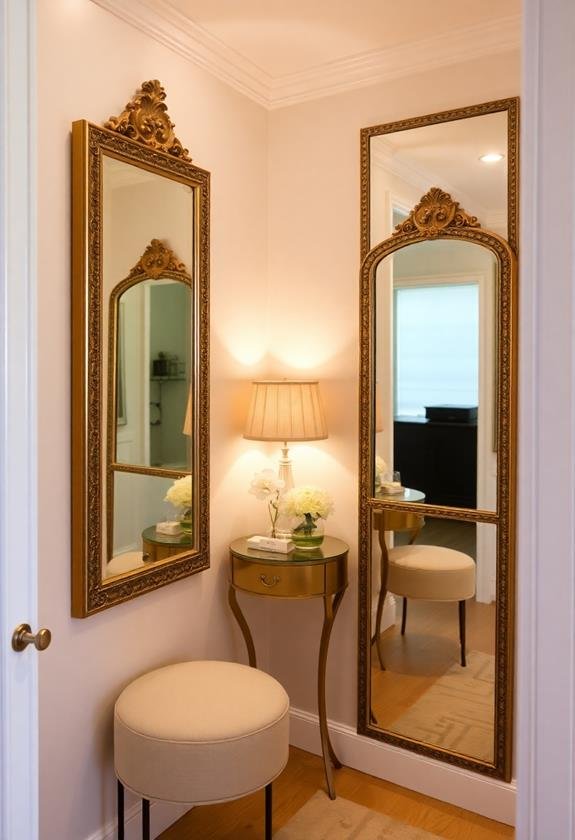
Strategic mirror placement can dramatically enhance the perception of space in small rooms. To maximize this effect, think about where you'll place your mirrors. Position them across from windows to reflect natural light, which creates an illusion of depth. This simple change can brighten up your space and make it feel more open. Additionally, consider mirrors with high-definition glass, as they provide bright, clear reflections that enhance the overall aesthetic of the room, high-quality reflection and durability.
You can also place mirrors on walls adjacent to doorways. This technique not only invites light into the room but also provides a sense of flow, making shifts between spaces feel seamless. Additionally, consider hanging a large mirror on a focal wall; it draws the eye and encourages the illusion of expanded dimensions.
If you have a narrow hallway or a small corner, think about using tall, vertical mirrors. These can create the impression of height, making the room feel airier. Avoid overcrowding the space with too many mirrors, as this may lead to visual chaos rather than a sense of openness. Instead, select a few key spots where mirrors can truly enhance the overall ambiance. By thoughtfully placing mirrors, you'll transform your small room into a more spacious and inviting area.
Types of Mirrors to Use
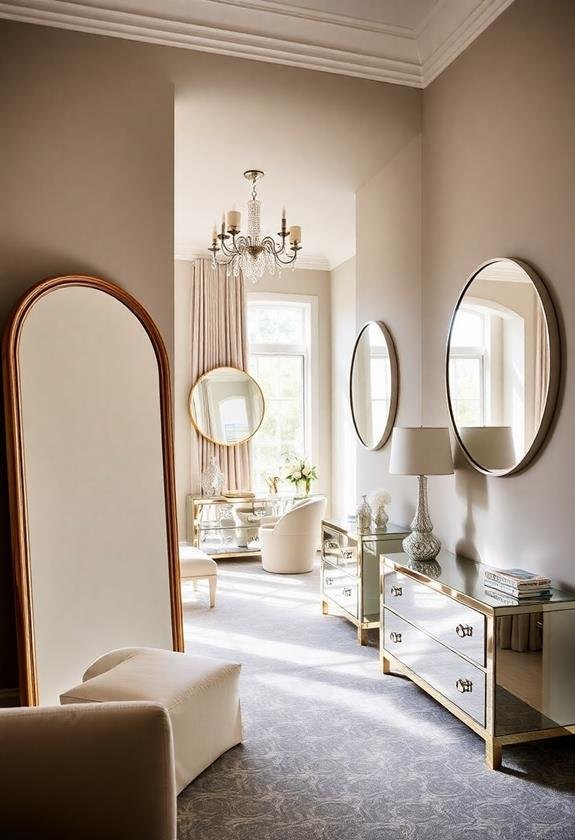
Mirrors come in various styles and shapes, each offering unique advantages for enhancing small rooms. For instance, large wall-mounted mirrors can create an illusion of depth, making your space appear more expansive. Opt for a floor-to-ceiling mirror if you want to maximize vertical space; it draws the eye upward and creates a more open atmosphere. You can elevate your decor by choosing mirrors that bring in stunning decorative elements to your living room.
You might also consider decorative mirrors, which not only reflect light but also serve as stylish focal points. Round mirrors can soften sharp angles in a room, while geometric designs can add a modern touch.
Don't overlook mirrored furniture, like side tables or dressers, which can reflect surroundings and make the room feel larger. If you want to add some flair, choose mirrors with interesting frames that complement your decor style.
Lastly, consider using multiple smaller mirrors arranged in a gallery style. This technique can create visual interest while simultaneously bouncing light around, enhancing the overall brightness of the room. By thoughtfully selecting the right types of mirrors, you can considerably transform your small space into a more inviting and spacious environment.
Layering Lighting Sources
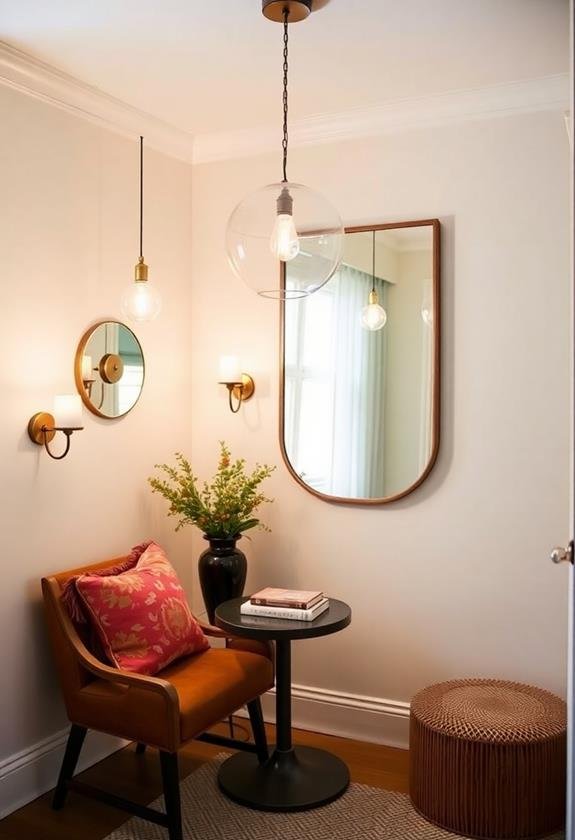
To maximize the spacious feel of small rooms, layering different lighting sources is key. When you combine various types of lighting, you create depth and interest, making the space feel larger and more inviting. Instead of relying solely on one overhead fixture, consider using a mix of ambient, task, and accent lighting to achieve the best results.
Here are four effective ways to layer your lighting:
- Ambient Lighting: Start with overhead lights or ceiling fixtures to provide a general glow throughout the room. Opt for fixtures that diffuse light, creating a soft overall brightness.
- Task Lighting: Incorporate lamps or sconces where specific activities take place, like reading or working. This focused light not only aids functionality but also adds warmth.
- Accent Lighting: Use spotlights or decorative fixtures to highlight artwork or architectural features. This draws the eye to different areas, enhancing the sense of space.
- Dimmers: Install dimmer switches to adjust the brightness based on your mood or time of day. This flexibility can make a small room feel more versatile and spacious.
Utilizing Natural Light
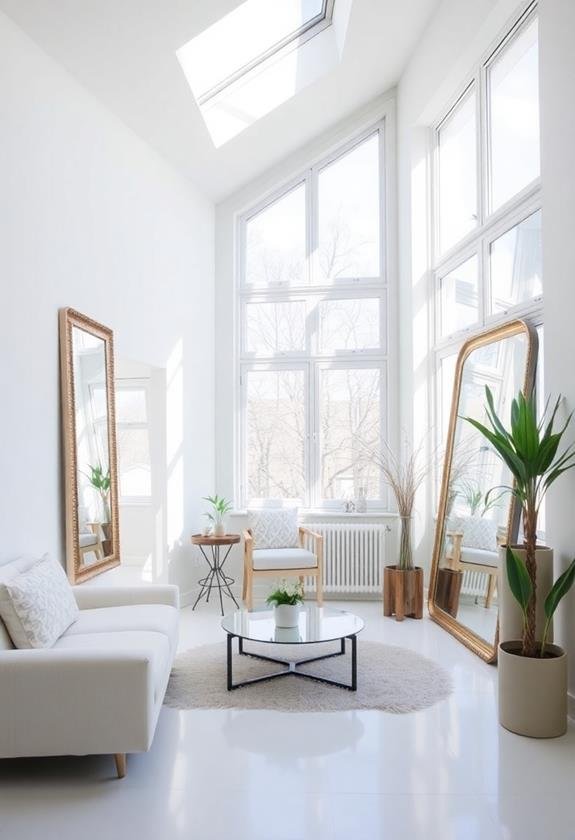
Natural light can transform a small room, creating an airy atmosphere that instantly makes the space feel larger and more open. To maximize this natural light, start by keeping your windows unobstructed. Avoid heavy drapes or bulky furniture that blocks sunlight. Instead, opt for sheer curtains that allow light to filter through while maintaining your privacy.
Position mirrors across from windows to reflect that natural light, amplifying its effect throughout the room. You might consider placing a large mirror on the wall opposite the window; this can create an illusion of depth, making the space appear more expansive.
Additionally, light-colored walls can enhance the brightness, allowing sunlight to bounce around the room effectively. If your room has a light-colored floor or ceiling, it will further contribute to a sense of openness.
Embrace the outdoors by keeping your windows clean and utilizing window sills for plants or décor that can bring in a touch of nature. This not only brightens the room but also invites a sense of peace, allowing you to enjoy the benefits of natural light while making your small space feel much more inviting and spacious.
Color Temperature and Brightness
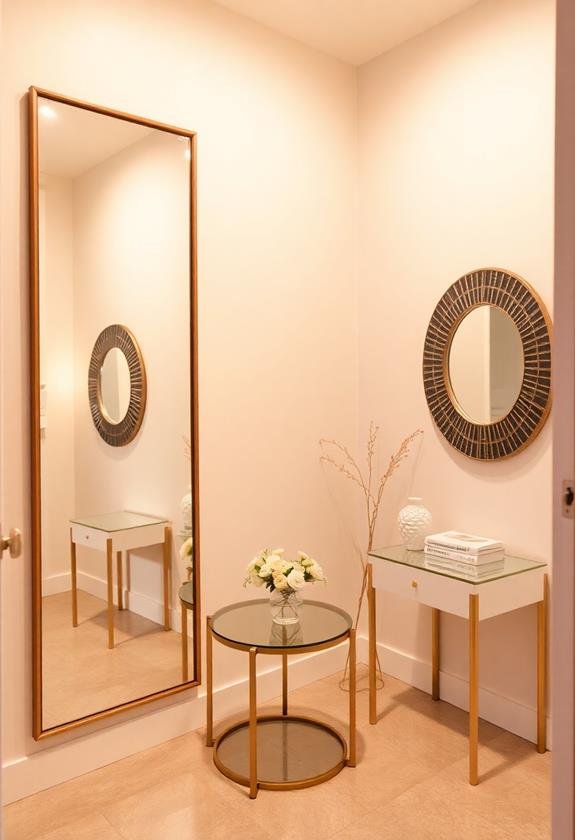
Choosing the right color temperature and brightness in your lighting can greatly impact how a small room feels. The warmth or coolness of the light can influence not only the room's ambiance but also how spacious it appears. Warmer lights tend to create a cozy atmosphere, while cooler lights can make a space feel more open and airy. Here are some tips to help you select the right lighting:
- Choose LED bulbs: They come in various color temperatures, making it easy to find the right fit for your needs.
- Opt for a higher lumen output: Brightness is key; brighter spaces generally feel larger. Aim for at least 800 lumens for a small room.
- Mix your light sources: Use a combination of overhead lighting, floor lamps, and wall sconces to create depth and dimension.
- Consider dimmer switches: These allow you to adjust brightness based on the time of day or mood, enhancing the room's versatility.
Avoiding Common Mistakes
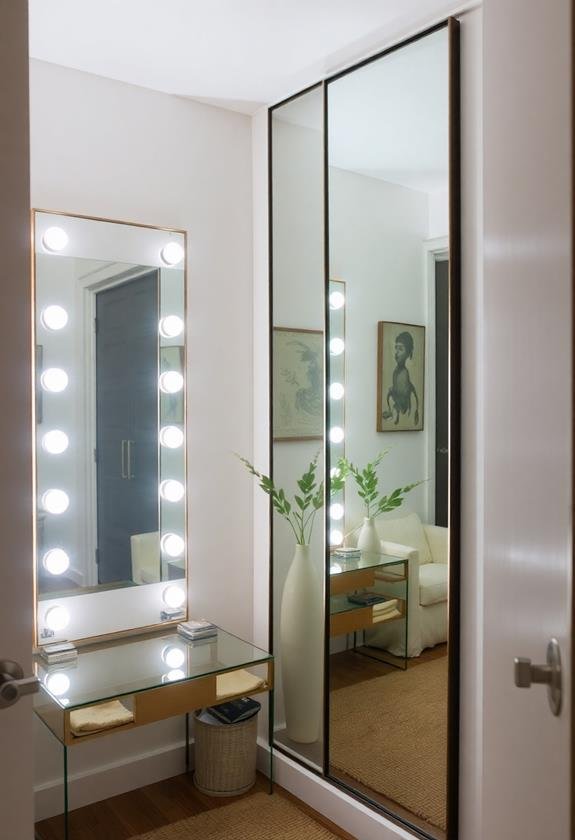
Even with the right lighting and color choices, small rooms can easily fall victim to common design mistakes that undermine their potential. One frequent error is overcrowding the space with furniture. It's tempting to fill every corner, but leaving some areas open can create a sense of flow. Choose multipurpose furniture instead, like ottomans with storage, to maintain functionality without clutter.
Another mistake is using heavy drapes. While they might seem cozy, they can make a room feel smaller. Opt for lightweight curtains or blinds that allow natural light to flood in. Speaking of light, avoid placing mirrors in poorly lit areas. Instead, position them opposite windows to maximize daylight and create the illusion of depth.
Also, be cautious with wall art. Too many small pieces can clutter the walls and overwhelm the space. Instead, consider one or two larger, statement pieces that draw the eye and enhance the room's sense of openness. Finally, don't neglect your color palette; dark colors on all walls can shrink a room visually. Instead, use lighter shades to brighten and enlarge your space. By avoiding these common pitfalls, you can truly enhance the perception of your small rooms.
Frequently Asked Questions
Can Mirrors Improve the Overall Ambiance of a Small Room?
Mirrors can notably enhance the ambiance of a small room. When placed strategically, they reflect light and create a sense of depth, making the space feel larger and more inviting. For instance, a well-placed mirror opposite a window not only brightens the room but also draws the eye, adding visual interest. By incorporating mirrors, you're not just improving aesthetics; you're transforming the room's overall atmosphere, making it feel more open and airy.
How Can I Clean Mirrors Without Leaving Streaks?
To clean mirrors without leaving streaks, you'll want to use a mixture of equal parts water and vinegar in a spray bottle. Spray the solution onto the mirror, then use a microfiber cloth or newspaper for wiping, as these materials reduce lint. Start at the top and work your way down, ensuring you wipe in a circular motion. If needed, dry the edges with a clean cloth to avoid any lingering moisture.
What Are the Best Light Bulbs for Small Spaces?
When choosing the best light bulbs for small spaces, consider LED bulbs. They provide bright, efficient illumination while using less energy. Soft white bulbs create a warm atmosphere, making the room feel cozy. Daylight bulbs, on the other hand, mimic natural light, enhancing colors and making spaces appear larger. You might also explore dimmable options for versatility. By selecting the right bulbs, you can markedly improve the ambiance and functionality of a compact area.
Are There Specific Mirror Shapes That Work Better for Small Rooms?
When choosing mirrors for small rooms, consider shapes that evoke a sense of fluidity, like round or oval mirrors. These shapes can soften the room's edges, creating an illusion of openness. Additionally, larger mirrors, regardless of shape, can reflect light and visually expand the space. Placing mirrors strategically—opposite windows or light sources—can enhance brightness and depth, making your cozy area feel more inviting and spacious without overwhelming the room's charm.
How Do I Choose the Right Color Scheme to Complement Mirrors and Lighting?
Choosing the right color scheme to complement mirrors and lighting is essential for creating a cohesive look. You'll want to select lighter hues like soft whites or pastels, as they reflect light, enhancing the room's brightness. Incorporating a few bolder accent colors can add depth and interest. Consider the existing furniture and decor—aim for harmonious combinations, like pairing a muted wall color with vibrant accessories to create a balanced and inviting atmosphere.

